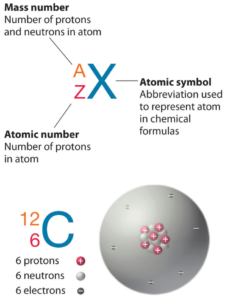Rhodium is a rare, silvery-white, hard, corrosion resistant and chemically inert transition metal. It is a noble metal and a member of the platinum group.
Protons and Neutrons in Rhodium
 Rhodium is a chemical element with atomic number 45 which means there are 45 protons in its nucleus. Total number of protons in the nucleus is called the atomic number of the atom and is given the symbol Z. The total electrical charge of the nucleus is therefore +Ze, where e (elementary charge) equals to 1,602 x 10-19 coulombs.
Rhodium is a chemical element with atomic number 45 which means there are 45 protons in its nucleus. Total number of protons in the nucleus is called the atomic number of the atom and is given the symbol Z. The total electrical charge of the nucleus is therefore +Ze, where e (elementary charge) equals to 1,602 x 10-19 coulombs.
The total number of neutrons in the nucleus of an atom is called the neutron number of the atom and is given the symbol N. Neutron number plus atomic number equals atomic mass number: N+Z=A. The difference between the neutron number and the atomic number is known as the neutron excess: D = N – Z = A – 2Z.
For stable elements, there is usually a variety of stable isotopes. Isotopes are nuclides that have the same atomic number and are therefore the same element, but differ in the number of neutrons. Mass numbers of typical isotopes of Rhodium are 103.
Main Isotopes of Rhodium
Rhodium occurs only in one natural isotope – 103Rh.
Rhodium-103 is composed of 45 protons, 58 neutrons, and 45 electrons.
Naturally Occuring Isotopes
| Isotope | Abundance | Neutron Number |
| 103Rh | 100% | 58 |
Typical Unstable Isotopes
| Isotope | Half-life | Decay Mode | Product |
| 99Rh | 16.1 d | electron capture | 99Ru |
| 101mRh | 4.34 d | electron capture or IT | 101Ru or 101Rh |
| 101Rh | 3.3 y | electron capture | 101Ru |
| 102mRh | 3.7 y | electron capture | 102Ru |
| 102Rh | 207 d | beta decay | 102Pd |
| 105Rh | 35.36 h | beta decay | 105Pd |
Electrons and Electron Configuration
The number of electrons in an electrically-neutral atom is the same as the number of protons in the nucleus. Therefore, the number of electrons in neutral atom of Rhodium is 45. Each electron is influenced by the electric fields produced by the positive nuclear charge and the other (Z – 1) negative electrons in the atom.
Since the number of electrons and their arrangement are responsible for the chemical behavior of atoms, the atomic number identifies the various chemical elements. The configuration of these electrons follows from the principles of quantum mechanics. The number of electrons in each element’s electron shells, particularly the outermost valence shell, is the primary factor in determining its chemical bonding behavior. In the periodic table, the elements are listed in order of increasing atomic number Z.
Electron configuration of Rhodium is [Kr] 4d8 5s1.
Possible oxidation states are +3.
Most Common Application of Rhodium
The element’s major use (approximately 80% of world rhodium production) is as one of the catalysts in the three-way catalytic converters in automobiles.Three-way catalytic converters have the additional advantage of controlling the emission of nitric oxide (NO) and nitrogen dioxide.
Summary
| Element | Rhodium |
| Number of protons | 45 |
| Number of neutrons (typical isotopes) | 103 |
| Number of electrons | 45 |
| Electron configuration | [Kr] 4d8 5s1 |
| Oxidation states | +3 |
Source: www.luciteria.com












